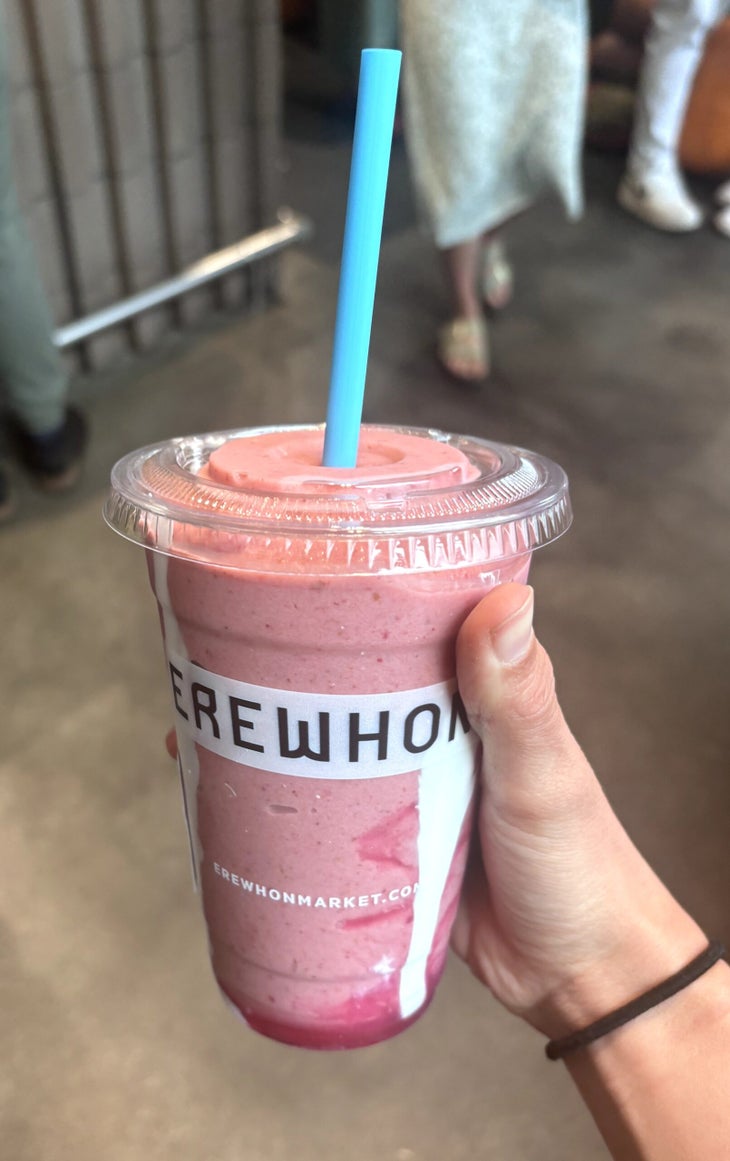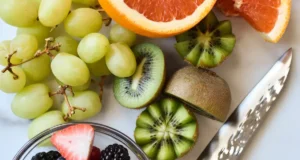A few months ago, I went to Los Angeles for a long weekend with my friend Becca to visit her relatives and soak in some sunshine. We both live in Bozeman, Montana and wanted to take a quick break in balmy southern California during the long, frigid northern winter.
Los Angeles tends to be at the vanguard of any health food fad, and the luxury grocery store chain Erewhon is the epicenter, the birthplace of dozens of dubious superfoods. In 2022, they started selling model Hailey Bieber’s sea moss-based Strawberry Glaze Skin smoothie, which quickly went viral. It gets its trademark pink coloring from a blend of almond milk, coconut cream, strawberries, avocados, dates, maple syrup, vanilla collagen, vanilla stevia, and the then-obscure sea moss.
Since then, sea moss has become ubiquitous among health-and-wellness types. Lately, fitness influencers are scooping heaps of sea moss gel, a colorless goo, into smoothies, coffee, and chia puddings—or just eating it straight off the spoon. Fans of the gelatinous substance claim that it boosts their immune system and improves gut and thyroid health. Some claim it increases libido. Others insist it’s an excellent substitute for face moisturizer and adds luster to their hair and nails.
What Is Sea Moss Gel?
Sea moss refers to a common type of red seaweed, also called Irish moss. The most common is a shallow-water red algae called Chondrus crispus, which grows wild along North Atlantic coasts and is farmed for commercial consumption. To make the gel, manufacturers (and enthusiasts who make it from scratch) soak or boil the plant with water until the consistency is smooth. You might have had sea moss without even knowing it, as it’s often used as a thickening agent and a vegan replacement for gelatin.
While Becca and I are health-conscious, we don’t usually get caught up in the latest superfood trend. However, the rosy drink’s association with Bieber piqued our interest because, you know, celebrities. We ordered one Hailey Bieber smoothie to share.
 The coveted pink smoothie. (Photo: Miyo McGinn)
The coveted pink smoothie. (Photo: Miyo McGinn)
I took a sip. It did not taste particularly good. And not because of the sea moss—whose taste is quite mild, sort of like a watered-down version of the salty, briny flavor I associate with saltwater plants. I couldn’t detect even a hint of oceanic flavor. Instead, it was dominated by the cloyingly sweet-without-sugar taste of stevia, vanilla, and dates. Combined with the creaminess from the avocado and coconut, you easily could have convinced me that they’d given me lotion from the Hailey Bieber skincare line advertised with the smoothie on the poster next to the cash register.
The smoothie also cost a jaw-dropping $20, which could buy a couple of hearty burritos back in Bozeman. The price tag has as much to do with Erewhon’s elite status as the not-so-modest cost of sea moss. An average serving of sea moss is one to two tablespoons of gel, and a 16-ounce jar on Amazon costs $30, which comes out to one to two dollars per serving. (It can also be found in some natural food stores.)
“Definitely not worth the $20 bucks,” Becca told me after she’d had a taste. “Very sweet and not very complex.”
Is Sea Moss Even Good for You?
Seaweeds have been a staple in some cultures’ cuisines for millennia and are known to be nutrient-dense and tasty. But, as is sometimes the case with viral health foods, few studies have been conducted on humans to support any of sea moss’s purported benefits. The sea moss gel you buy at a health food store is considered a supplement by the Food and Drug Administration (FDA), which means that the advertised health effects don’t have to be backed up by scientific research.
Labeling It a Superfood May Be a Stretch
“Some companies promote sea moss as a good source of nutrients that can improve gut health and immunity, such as fiber, vitamins A & C, zinc, and selenium,” says registered dietician Alyssa Pacheco. In reality, a two-tablespoon serving of sea moss equates to less than two percent of your daily recommended intake of these nutrients. “You would probably get an equal or better nutritional boost from a multivitamin,” she says.
So claims that sea moss is good for, say, your immune system are based on its vitamin C and zinc content, which Pacheco says are known to support immune health. But the amount of those minerals that you’ll find in a couple of scoops of sea moss gel is negligible. The same is true for all the other supposed benefits of the vitamins and minerals that can be found in sea moss. “In the typical recommended dose, sea moss isn’t a very good source of most nutrients,” says Pacheco.
Research does suggest that many of the bioactive compounds (peptides, amino acids, and even longer names that you might recognize from shampoo bottles) found in seaweeds can contribute to skin and hair health; however, most studies consider products applied directly to the body rather than consumed. As for libido, a study of rats did document increased libido and fertility, but more studies on humans are still needed to say for sure.
The Potential Risks of Consuming Sea Moss Gel
Sea moss contains iodine. While the mineral is beneficial in small amounts, too much can lead to thyroid complications. Depending on the water quality where the sea moss was obtained, the gel may contain heavy metals like arsenic and mercury that it soaked up from its environment. According to Pacheco, there’s not much danger in trying sea moss if you have your heart set on it. Just stick to the recommended serving size, and talk to your doctor if you’re worried about iodine content.
Personally, I’ve tried exactly one more sea moss smoothie than I need to. I’ll stick to nori and kombu (the thick kelp sometimes in Japanese dishes like miso soup) for my seaweed fix and continue drinking smoothies with nut milk and fruit that don’t taste too sweet. My skin almost certainly won’t be as good as Hailey Bieber’s, but I suspect that doesn’t actually have much to do with our relative sea moss consumption.




